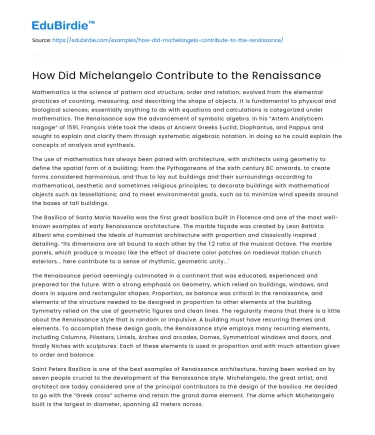Mathematics is the science of pattern and structure, order and relation; evolved from the elemental practices of counting, measuring, and describing the shape of objects. It is fundamental to physical and biological sciences; essentially anything to do with equations and calculations is categorized under mathematics. The Renaissance saw the advancement of symbolic algebra. In his “Artem Analyticem Isagoge” of 1591, François Viéte took the ideas of Ancient Greeks Euclid, Diophantus, and Pappus and sought to explain and clarify them through systematic algebraic notation. In doing so he could explain the concepts of analysis and synthesis.
The use of mathematics has always been paired with architecture, with architects using geometry to define the spatial form of a building; from the Pythagoreans of the sixth century BC onwards, to create forms considered harmonious, and thus to lay out buildings and their surroundings according to mathematical, aesthetic and sometimes religious principles; to decorate buildings with mathematical objects such as tessellations; and to meet environmental goals, such as to minimize wind speeds around the bases of tall buildings.
Save your time!
We can take care of your essay
- Proper editing and formatting
- Free revision, title page, and bibliography
- Flexible prices and money-back guarantee
The Basilica of Santa Maria Novella was the first great basilica built in Florence and one of the most well-known examples of early Renaissance architecture. The marble façade was created by Leon Battista Alberti who combined the ideals of humanist architecture with proportion and classically inspired detailing. “Its dimensions are all bound to each other by the 1:2 ratio of the musical Octave. The marble panels, which produce a mosaic like the effect of discrete color patches on medieval Italian church exteriors... here contribute to a sense of rhythmic, geometric unity...'
The Renaissance period seemingly culminated in a continent that was educated, experienced and prepared for the future. With a strong emphasis on Geometry, which relied on buildings, windows, and doors in square and rectangular shapes. Proportion, as balance was critical in the renaissance, and elements of the structure needed to be designed in proportion to other elements of the building. Symmetry relied on the use of geometric figures and clean lines. The regularity means that there is a little about the Renaissance style that is random or impulsive. A building must have recurring themes and elements. To accomplish these design goals, the Renaissance style employs many recurring elements, including Columns, Pilasters, Lintels, Arches and arcades, Domes, Symmetrical windows and doors, and finally Niches with sculptures. Each of these elements is used in proportion and with much attention given to order and balance.
Saint Peters Basilica is one of the best examples of Renaissance architecture, having been worked on by seven people crucial to the development of the Renaissance style. Michelangelo, the great artist, and architect are today considered one of the principal contributors to the design of the basilica. He decided to go with the “Greek cross” scheme and retain the grand dome element. The dome which Michelangelo built is the largest in diameter, spanning 42 meters across. This is one part of the rivalry between Italian cities of the Renaissance, where Michelangelo and his contemporaries wanted to outdo the great achievement of Filippo Brunelleschi. Brunelleschi was considered the critical founding figure of Renaissance architecture, and he was the first to accomplish building a grandiose dome since times of antiquity – his legacy is the grand cathedral of Florence, with the famed “Brunelleschi dome”.






 Stuck on your essay?
Stuck on your essay?

